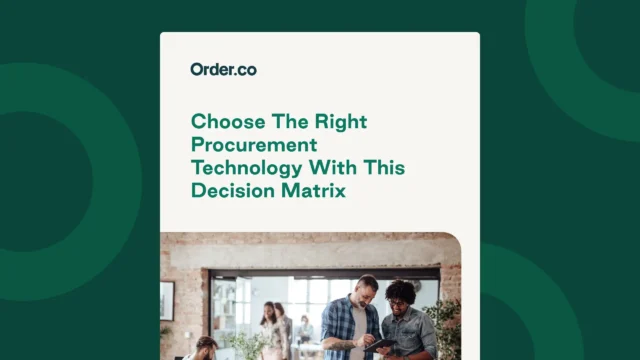How to Choose the Right Vendor Management System

How to Choose the Right Vendor Management System
The thought of choosing a vendor management system might make your skin crawl. When would you even find the time? But like most finance and operations professionals, you know if you don’t do it now, you’ll be wishing you did as your department gets busier.
A vendor management system (VMS) can profoundly impact your business and its day-to-day operations. This solution centralizes purchasing, budgeting, vendor selection, delivery tracking, invoicing, and reporting. Managing these processes is time intensive and costly, which explains why more than half of companies are currently focusing on digital transformation as a top priority.
But how do you choose the right VMS: one within the budget that will address your unique day-to-day challenges?
It isn’t complicated if you are pragmatic in your approach. To help, we’ve created the following roadmap, with an overview of the key features you’ll want in your VMS automation software. Let’s take a look.
Download the free ebook: Choose the Right Procurement Technology With This Decision Matrix
What is a vendor management system (VMS)?
A vendor management system is a cloud-based software tool that helps organizations track and manage the supplier relationships that keep their businesses moving forward. A vendor management system centralizes data for each of the suppliers or service vendors a company works with. Common data stored within a VMS includes the following:
- Supplier contact information
- Supplier payment details and terms
- Copies of vendor agreements
- Standard purchase price data
- Historical purchase requisitions or purchase orders
- Vendor invoice images and due dates
- Payment confirmations
- Vendor lifecycle evaluation data
- Supplier performance evaluations
- Notes and supporting documentation
Why are vendor management systems important?
Organizations conduct business with a growing number of external vendors. Managing dozens or hundreds of vendor relationships manually can lead to costly and time-consuming issues with ordering, compliance, and payment, and overall vendor risk management.
Implementing a software solution for managing and centralizing your vendor data reduces or eliminates these issues.
By using a vendor management system to track supplier agreements and relationships, organizations can reap substantial benefits:
- Reducing spending on materials, goods, and services
- Consolidating suppliers into a preferred program
- Tracking reorder and renewal information
- Improving supplier compliance rates
- Streamlining the procurement strategy and process
- Automating the accounts payable (AP) process
- Improving decision-making through better data visibility
How vendor management systems save money
Though it may seem contradictory, investing in the right vendor management system can result in net savings for your organization. It can reduce your bottom line, eliminate discrepancies due to human error, and free up your team from manual processes. All of these have the potential to reduce the overhead costs associated with AP department administration, invoice processing, and data entry. With automation, there are many ways to save:
- Reducing the cost to process an invoice by up to 80%
- Increasing invoice processing flow from tens to thousands per day
- Eliminating costly and time-wasting invoice exceptions
- Taking advantage of early payment discounts for timely payments
- Reducing financial liabilities from third-party risk
All this being said, it’s essential to choose the best VMS solution for your business and its unique needs. Let’s look at the features that make a vendor management system useful. What features should a vendor management system have?
Steps to choosing a vendor management system
The process for selecting a vendor management system should be thorough and carefully considered. It should address any pain points your business currently experiences and offer solutions for improving your vendor management processes.
Establish goals for the system
It may sound obvious, but the first step to choosing a vendor management system is understanding why you need one. If you identify the pain points you want to solve before you kick off your search, you’ll bring direction to your research, which will enable you to measure each solution by its ability to meet your specific objectives. Think about this in both the short and the long term.
Ask yourself some questions:
- How much accounts payable automation (if any) do we currently use?
- What are the most pressing problems with our current vendor management and accounting system?
- How often does the accounts payable department deal with issues like invoice exceptions, late payments, double-entry issues, or late fees?
- Has the team encountered wide-scale issues such as fraudulent invoices or missing invoice payments?
Based on the above information, you may determine some short-term or long-term goals for your procurement function.
Assess your current system
Once you determine what you need most, look at what you have currently in place. Understanding how AP automation will fit into the larger tech stack and approval process can help guide decision-making.
If your organization has existing systems in place (either manual or automated), ask the following:
- Do we currently have a procure-to-pay system in place, and is it fit for service according to our current operations?
- What internal controls or workflow options are currently in place for things like invoice approval, three-way matching, vendor payments processing, etc.?
- How do we currently access, edit, and use invoice data? What data formats do we need to incorporate?
Examine integration potential
The vendor management system you select should be compatible with your existing tech stack without jeopardizing your company’s data. Consult with your IT and compliance teams to ensure that the solutions you’re considering work well with the technology you already use and that you can trust each one to protect your data.
- Start by setting up a quick call with someone on your IT team. Let them know you are considering a few software solutions, and ask whether there are any questions you should ask vendors about application programming interfaces (APIs). Your IT team may have documented requirements or supplier questionnaires available to use.
- Then, reach out to your compliance department as part of the interdepartmental approval process. They can help you evaluate whether vendors are housing company data safely. They may even have established criteria that all vendors must meet.
- Based on this information, identify at least three suppliers or AP automation solutions that may fit your current business processes and meet your future goals. Look for a solution that offers a flexible and intuitive platform, a high level of security for sensitive data like financial statements and payment processing, and plenty of integration options.
Prepare for VMS product demos
Once you’ve identified the vendors you want to consider, set up a demo with each. During these demos, control the narrative by focusing on what you need from a vendor management system to succeed.
Before the demo, prepare a list of questions you’ll need answered in order to feel confident enough to make a decision. Have a sense of your budget and estimate how much you hope to save by investing in vendor management software. You can also ask a member of your IT team to join the demo if it makes you feel more confident.
At the beginning of the demo, remind the sales representative of your pain points and goals. This will help ensure that he or she focuses on your unique needs, and it will set up the conversation to address your specific questions.
Evaluate vendor management systems with a scorecard
Once you have evaluated the product offering for each shortlisted supplier, you should be close to a decision. If you have difficulty choosing between two closely matched options, consider using a decision matrix to clarify your needs and advance to a final decision.
The following matrix covers key decision criteria for a vendor management solution. To use the matrix, answer each question on the left on a scale of 1 to 5 and note it in the column on the right. Tally up your responses for a final score. Do this for each vendor, and then select the vendor with the highest score.
Question | Rating (1–5) 1: Strongly disagree 2: Disagree 3: Sort of agree 4: Agree 5: Strongly agree |
|---|---|
Is the VMS within my budget? | |
Will the VMS recommend alternative brands and products that may save my business money? | |
Is the VMS likely to bring savings of at least 8% to my business purchasing? | |
Will the VMS reduce the number of people needed to complete a purchase? | |
Will the VMS make the purchasing process faster? | |
Do I trust the VMS to house my company’s data? | |
Will the VMS make it easier to set and enforce budgets? | |
Will the VMS help to integrate finance, operations, and purchasing in one platform? | |
Will the VMS enable my business to make purchases for multiple locations in one order? | |
Will the VMS allow my team members to streamline approvals? | |
Do I trust the business behind the VMS to onboard my team and troubleshoot any issues we may have using the software? | |
Does the VMS provide invoicing data validation and purchasing reports? | |
Does the VMS integrate with other software solutions in my company’s existing tech stack? | |
| TOTAL SCORE |
Feel confident about your VMS decision
By taking the time to evaluate and select the right vendor management system, you can arrive at a decision and implement it with confidence.
Order.co brings together the best features of a vendor management system in an intuitive platform. It works with enterprise resource planning (ERP), finance, and accounting solutions to provide total visibility into your financial life. It offers full automation of the AP process and flexibility to serve your business across all locations and applications. With Order.co, your purchasing department can shed the busywork and build stronger supplier relationships with ease.
To see how Order.co could fit within your organization, schedule a demo.
Get started
Schedule a demo to see how Order.co can simplify buying for your business.
"*" indicates required fields



